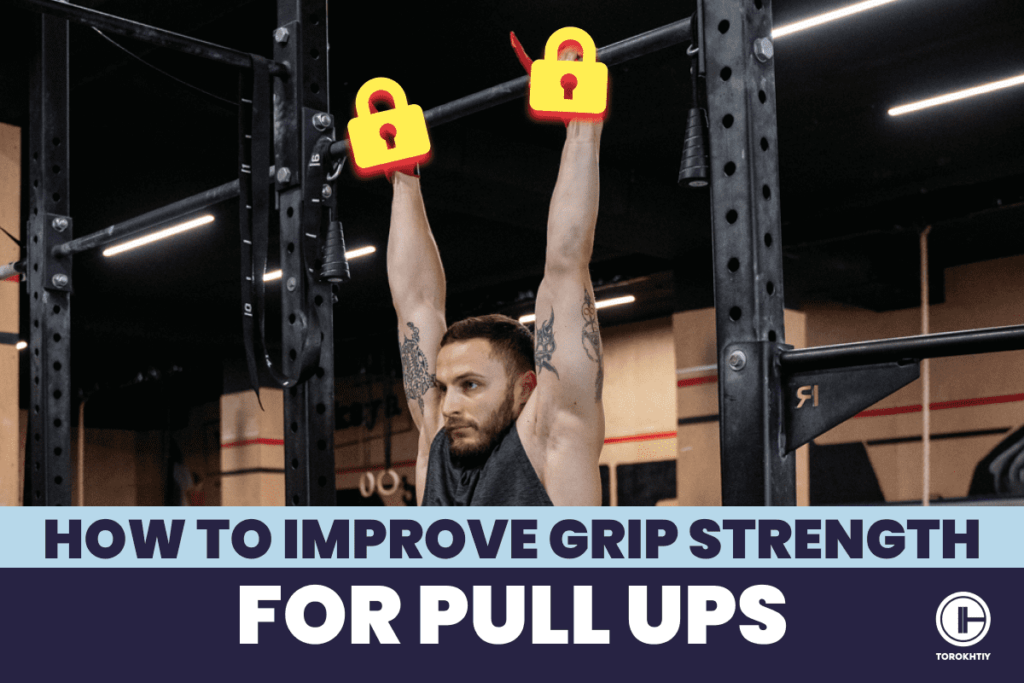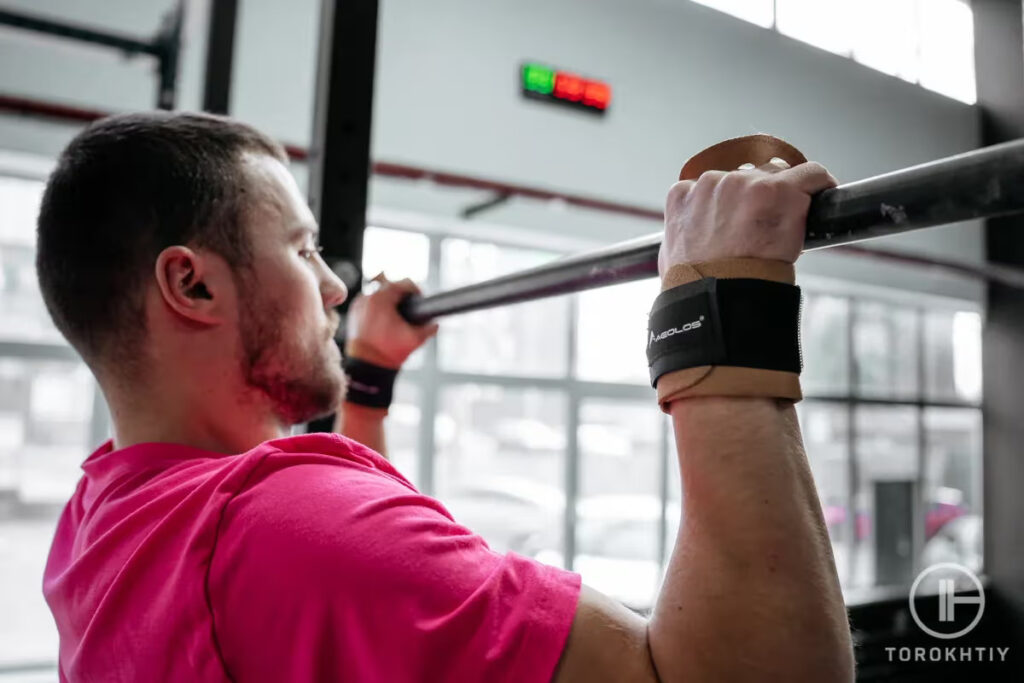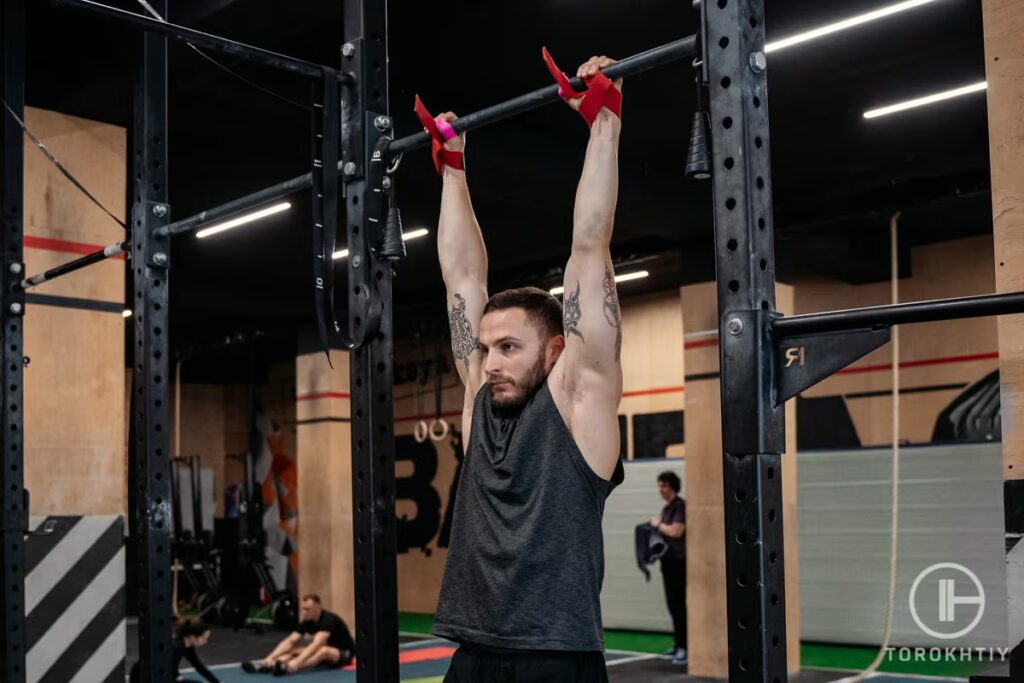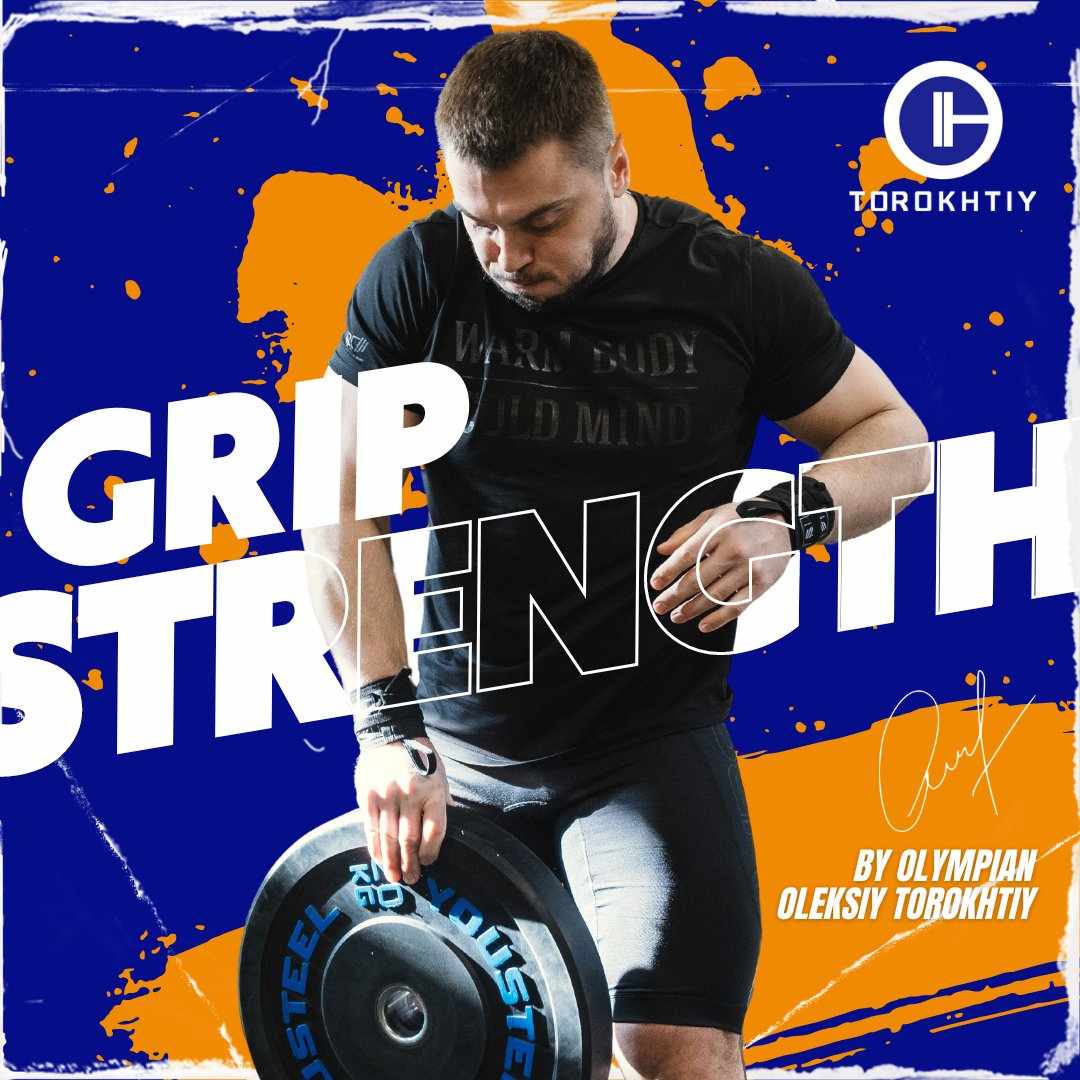How To Improve Grip Strength For Pull-Ups: Ultimate Guide
Author:
Reviewed by:
(Certified Nutritionist, S&C specialist, M.Sc.Eng. Biotechnology)
Unlock your full potential by engaging with our experts and community! Have questions about your fitness journey or looking for expert advice on weightlifting techniques? Don’t hesitate — leave a comment below and Sergii Putsov will provide a personalized answer and insights to help you reach your goals.
Torokhtiy is reader-supported. Some links are affiliate links, and we may earn a commission at no extra cost to you. See our disclosure page for details.
If you’re struggling with pull-ups, don’t worry, you’re not alone. A lot of people have issues, mostly because of their weak grip, but stick around because we’re going to show you how to improve grip strength for pull ups!
We all know pull-ups are fantastic, which is why we’re willing to struggle a bit and endure the discomfort that comes with doing them. The thing is, they rely heavily on your ability to keep a solid grip on the bar, so if your grip is weak, the exercise will be way more challenging than it needs to be.
You might slip, you won’t be able to pull yourself up properly and overall, you’ll end up being more annoyed than anything else. But the good news is, there’s a whole range of techniques that can help make your grip stronger and if you stay consistent, you’ll crush those pull-ups like a pro.
Roll up your sleeves and let’s get a grip on those pull-ups!
How to improve grip strength for pull ups? Focus on both compound (deadlifts, farmer’s carry, rows, etc.) and specific exercises to strengthen your grip. You can even get grip strengtheners to complement your routine, but the key is consistency; practice regularly or you won’t see improvements.

Grip Strength and Pull-Ups – Overview
Having a strong grip is more than just being able to hold things tightly because, if you really think about it, you’ll realize that it’s a crucial aspect of your everyday life. You need a grip for typing on a keyboard, opening jars, carrying bags, moving furniture, working out… There’s practically no end to this list.
And aside from all the stuff you need a good grip for, studies have shown that a strong grip is linked to your overall body strength.
Another study from 2019 linked strong grip with better health in general, while a recent study from 2022, which included over 40,000 participants, showed that a strong grip can mean better cognitive function.
So, you see, even though a strong grip is important for pull-ups and workouts in general, it can even be an indicator of how healthy you are, or whether you’re at risk for certain diseases. This is because people who have a strong grip are generally well-trained and they are physically active on a regular basis.
When talking about pull-ups specifically, you simply won’t be able to do them if your grip is weak. Your hand is a connection point between you and the pull-up bar so, if your grip gives out, it doesn’t matter if you have the strongest arms and back in the entire world, you still won’t be able to pull yourself up.
Grip strength and pull-ups go hand in hand (yes, that pun was intentional) and when you take the time to strengthen your grip, you’ll improve both the performance in pull-ups and overall functional strength and well-being.
Keep in mind, there are a few different grip types you can use: the pronated grip (palms facing away), the supinated grip (palms facing toward you), and neutral grip (palms facing each other). Although you might have a favorite, each grip targets slightly different muscles, so you need to develop strength in all of them because you want your pull-up game to be well-rounded.
Follow us!

Free!
Get a 2-week Weightlifting Program as a bonus for the subscription to kickstart your training plan!

Free!
How to Improve Grip Strength for Pull-Ups?
The amount of weight you can lift or how long you can hold a particular posture is often determined by how strong your grip is, meaning that the pull up grip strength directly influences your performance. The stronger your grip, the better the performance, but a strong grip won’t just help in that regard. It will make your workout safer and more effective, so let’s see what you can do to work on that.
1. Compound Movements
Compound movements are a strategic way to boost your overall strength and that includes your grip. Since all of these exercises need a lot of different muscle groups to be engaged at the same time, the effect that they give is comprehensive.
Take deadlifts, for example. They challenge your grip every single time you lift the barbell off the ground, so your forearms are engaged, but so is the rest of your body.
Rows (both dumbbell and barbell) are another good way to increase grip strength for pull ups. You need a strong grip to pull the weight towards your torso, so your grip and back get a good workout. Farmer’s carry is an excellent exercise for endurance because, when you carry heavy weights over a distance, your grip is forced to keep the hold of the weights.
It wouldn’t make sense to finish this part without pull-ups. Do pull ups increase grip strength? Of course they do! As you pull yourself up, your hands, wrists, and forearms become stronger, so you’re strengthening your grip and getting better at pull-ups. It’s a win-win!
Basically performance of any pull exercise you would like to do, will be as good as your grip strength, meaning even if your pull is strong if you can’t hold it – you can’t pull it. Unless you are using lifting straps 😉
Tips From the Champ
Try using thick bars to increase the challenge on your hands and forearms. Not only will this lead to greater gains, but the change in the bar’s diameter can address weaknesses and imbalances in your grip strength that may go unnoticed with standard equipment.
Olympic Weightlifting Champion
2. Specific Exercises
If you want to really work on the strength of your grip, you should definitely include some targeted exercises in your routine. Compound movements are great, but specific exercises will target the muscles you’re trying to strengthen more precisely.
One of these exercises is wrist push-ups. They target your wrists and forearms and they’re pretty simple. You start in a kneeling position with hands palms-up, facing each other and wrists bent. Then, straighten your wrists and push up so your hands end up forming fists. Then just bend your wrists again and return to the starting position.
This exercise challenges the stability and strength of the wrist joint and surrounding muscles.
Disc juggling is a dynamic exercise that will improve your grip strength, make your forearm muscles stronger, and improve hand-eye coordination. Grasp the weight plate by its top edge with one hand and toss it slightly into the air, then catch it with another hand by the opposite edge.
This challenges your small stabilizing muscles in the hands and forearms, as well as your reflexes. Make sure to use a light weight until you fully master the technique.
Then there are dumbbell wrist curls, which are a staple in this category. They isolate the forearm flexors and directly impact the strength of your grip. You’ll need a bench and a dumbbell for this one. Rest one forearm on the bench with your hand and a dumbbell hanging over the edge.
Flex your wrist to curl the dumbbell up and then lower it back down with control. You should do this with a full range of motion and engage the muscles responsible for gripping.
If you want something innovative and fun, we’ve got you covered with kettlebell wrist rolls, except you’ll use a band with this. Loop a resistance band around a barbell on the rack and attach a kettlebell on the other end.
Then, grip the bar and roll it, winding the band to lift the kettlebell. This works your forearms through a full range of motion and the progressive resistance of the band adds a really unique challenge.
Lastly, there are wrist levers, or wrist rotations, however you want to call this. It’s super simple, but very effective for your forearms and grip. Hold a PVC pipe in each hand and rotate your wrists to lever the long end of the pipes up and down.
The pipes’ length will create leverage, which will force the grip and forearms to work harder. It’s simple enough that it fits in any training regimen, and you can use it before or after a workout.
3. Methods and Principles
• Progressive Overload
Apart from the exercises, there are a few other things you need to keep in mind in order to keep developing your grip strength and not hit plateaus. Progressive overload, meaning you increase the weight, duration, and number of reps gradually, is going to make sure your grip develops continually, and it will allow your muscles to adapt to the stress.
• Recovery
This is something a lot of people underestimate (especially beginners), but rest and recovery are just as important as working out if you want to see improvements. Make sure you give your muscles plenty of time to rest and develop between the workouts or you’ll stall your progress, and you can end up injured.
It can be tempting to work out every single day, especially if you’re anxious to see results, but if you do that, your muscles will have no problem showing you how unhappy they are with it.
Tips From the Champ
If you want to expand your grip training arsenal, you can do so with specialized tools like grip strengtheners, hand grippers, or grip balls. They’re designed to provide targeted resistance to the muscles involved in gripping, so they’ll help you improve both your strength and endurance.
Olympic Weightlifting Champion
How to Measure Grip Strength?
Nothing is more motivating than seeing progress, but can you measure it? You absolutely can! There are ways to see exactly how strong your grip is and what you’re starting from.
1. Why It’s Important – Setting Baseline for Progress
Before you start, it’s good to see what your baseline measurement is. This will be your reference point for tracking improvements over time and it will allow you to see areas you need to improve.

2. Hand-Grip Dynamometer
This is a specialized device that is precise enough to be used in research and clinical trials, so if you want the most accurate information possible, a hand-grip dynamometer is your best bet. You squeeze it as hard as you can, and it shows standardized, objective measurements.
3. Pull-Up Bar Hanging
This won’t give you any numbers or precise measurements, but it’s still a good way to see whether you’ve improved anything. Just hang from a pullup bar for as long as possible and it will evaluate your endurance and strength.
The timeframe should change over time, so you’ll be able to see if you’ve progressed or not. Too easy – add extra weight and see how long you can hand 😉

4. Farmer’s Carry
Grab heavy dumbbells or kettlebells with an overhand grip and walk for a specific amount of distance or time. Good start is to check how long you can carry half of your body weight. This will test your grip strength, but it will also challenge your stability and core strength.
You can use it to check your progress and, since it mimics real-life scenarios (like carrying groceries or luggage), it’s also very functional.
Conclusion
If you’ve been asking yourself, ‘does grip strength help with pullups’, hopefully you got your answer. With all of these exercises, tools and just information in general, you might feel like you have to do so much to get your grip stronger, but that’s not the case. Look at all of this like a buffet – you have a selection of ways to strengthen your grip, and you can pick and choose what you like best.
Hit some weights, then throw in some specific isolation exercises like wrist push-ups or disc juggling to pay special attention to the muscles that are involved in gripping. The golden rule is to keep things challenging, but manageable with progressive overload, but remember to give your muscles some downtime for recovery.
What’s your go-to exercise or tool for getting your grip stronger? Have you faced any problems and what did you do to take care of them? Got any gadgets on your wishlist? What’s your best post-workout recovery hack (asking for a friend, of course)?
Let’s swap ideas, opinions, and keep the discussion going!
Also Read:
- 8 Squat Cues For Perfect Form And Strength
- 12 Exercises To Improve Squat Strength & Form
- Elbow Pain from Pull Ups: Reasons and Solutions
- Rack Pull vs Deadlift: Which Is More Effective?
- Front Squat Grip Secrets – Techniques & Tips
- 5 Essential Grip Strength Benefits for Health & Performance
References
- Becks Shepherd “Why are rest days important?” LiveScience, https://www.livescience.com/why-are-rest-days-important (accessed April 4th, 2024)
- Howard E. LeWine, MD “Grip strength may provide clues to heart health,” Harvard Health Publishing, https://www.health.harvard.edu/blog/grip-strength-may-provide-clues-to-heart-health-201505198022 (accessed April 4th, 2024)
- John Cronin, Trent Lawton, Nigel Harris, Andrew Kilding, Daniel T. McMaster “A Brief Review of Handgrip Strength and Sport Performance,” Journal of Strength and Conditioning Research 31, no. 11 (November 2017): 3187-3217.
- Richard W. Bohannon “Grip Strength: An Indispensable Biomarker For Older Adults,” Clinical Interventions in Aging 14 (2019): 1681–1691.
- Rongtao Jiang, Margaret L. Westwater, Stephanie Noble, Matthew Rosenblatt, Wei Dai, Shile Qi, Jing Sui, Vince D. Calhoun, Dustin Scheinost, “Associations between grip strength, brain structure, and mental health in > 40,000 participants from the UK Biobank,” BMC Medicine volume 20, Article number: 286 (2022).
- Photos made by Torokhtiy Media Team.
Why Trust Us?
With over 20 years in Olympic weightlifting, strength training, nutrition coaching, and general fitness our team does its best to provide the audience with ultimate support and meet the needs and requirements of advanced athletes and professional lifters, as well as people who strive to open new opportunities and develop their physical capabilities with us.
By trusting the recommendations of our certified experts in coaching, nutrition, and sports training programming, as well as scientific consultants, and physiotherapists, we provide you with thorough, well-considered, and scientifically proven content. All the information given in the articles concerning workout programming, separate exercises, and athletic performance, in general, is based on verified data.
The product testing process is described in more detail here.
Author: Sergii Putsov
Head of Sport Science, PhD
Best Results: Snatch – 165 kg,
C&J – 200 kg
Sergii Putsov, Ph.D., is a former professional weightlifter and National team member, achieving multiple medals in the 94 kg weight category at national competitions. With a Master’s degree in “Olympic & Professional Sport Training” and a Sport Science Ph.D. from the International Olympic Academy, Greece, Sergii now leads as the Head of Sport Science. He specializes in designing training programs, writing insightful blog articles, providing live commentary at international weightlifting events, and conducting educational seminars worldwide alongside Olympic weightlifting expert Oleksiy Torokhtiy.
Reviewed by: Jacek Szymanowski
Certified Nutritionist,
M.Sc.Eng. Biotechnology
Performance architect,
Strength and Conditioning Specialist
With over 30 years of fighting experience, specialization in nutrition coaching for athletes, and expertise in metabolic health and dietary strategies, Jacek offers a comprehensive approach to optimizing your performance and well-being. Backed by a Master of Science degree in Biotechnology, Jacek remains at the forefront of scientific advancements, ensuring that his coaching is always evidence-based and up-to-date.






Still have questions after reading our article? Unlock your full potential by engaging with our experts and community! Don’t hesitate — leave a comment below and Sergii Putsov will provide a personalized answer and insights to help you reach your goals.